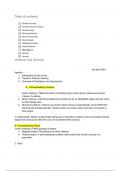Summary
Summary Violence and Security 2nd year
- Course
- Institution
It includes questions with detailed answer that systematically covers the entire content. It has one document with just reading and lecture notes with a table of content from 2nd year political science.
[Show more]



